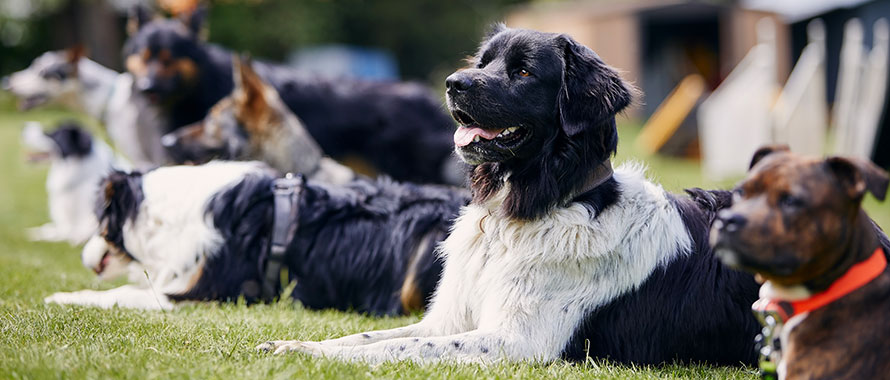While the number of dog bite claims has dipped, the cost of dog bite claims has been growing significantly, new data from the Insurance Information Institute shows. Last year, the number of claims decreased 2.2%, but claim costs grew 32% to a per-claim average of $64,555, Property Casualty 360 recently reported. These claims totaled $1.3 billion in 2022, representing a 28% increase from 2021, the publication noted.
States with the most dog bite claims in 2022 included Florida, with 1,331 claims and a per-claim average of $78,203, and California, which saw 1,954 claims last year at an average of $78,818 each, according to the association.
Featured Solutions
“Homeowners assume dog bites are automatically covered; this is simply untrue,” Murphy said.
In Canada, 35% of households own at least one dog, a number that is also growing. Owners need to be aware of the risks because dog attacks can be fatal or cause life-altering injuries, said Michelle Allemang, Manager, Personal Insurance, Canada, Burns & Wilcox, Vancouver, British Columbia. “When these unfortunate incidents occur, they can cause severe damage,” she said. In both the U.S. and Canada, “You are held liable for the actions of your dog. If you do not have the proper insurance, you could really be on the hook for some significant costs.”

You are held liable for the actions of your dog. If you do not have insurance, you could really be on the hook for some significant payouts.
Business owners are also at risk and may or may not have dog bite coverage under their Commercial General Liability (CGL) Insurance, said Ryan Short, Underwriter, Commercial Insurance, Burns & Wilcox, Atlanta, Georgia.
“The more and more we incorporate dogs into our daily lives — going to restaurants, breweries, and sports games even — they are just everywhere,” Short said. “With the potential of needing plastic surgery and ongoing medical care, especially if there is nerve damage, these can turn into chronic issues and that is why you see an average dog bite claim of over $60,000.”
Dog bite exclusions increasingly common as claim costs rise
According to the American Veterinary Medical Association, over 4.5 million individuals in the U.S. suffer a dog bite each year — at least half of whom are children — and more than 800,000 seek medical attention for a dog bite. In Canada, one study found that dog bite injuries prompted more emergency room visits than ice hockey injuries for kids ages 5 to 9 and more ER visits than trampoline incidents for kids 10 through 14, according to a 2021 report by the University of Calgary.
When a homeowner’s dog bites a guest or other third party — whether the bite occurs in the home or while the dog is outside, being taken for a walk, or elsewhere — the homeowner is likely to face a claim, Murphy said. Homeowners Insurance could cover the injured individual’s medical costs, pain and suffering, loss of income if they are unable to work due to the bite, and more.
“A dog bite, regardless of who is injured, will most likely result in medical payout on Homeowners Insurance coverage, [and will often] escalate to a lawsuit,” she said. With rising defense costs and other expenses, “before a lawsuit is even decided, there are already thousands of dollars spent.”
Homeowners can also be sued when their dog attacks another individual’s pet, Murphy added. “It is important to understand that we are not just seeing dog-to-human bites. There are also dog-on-dog bites that are a factor now,” she said.

A dog bite, regardless of who is injured, will most likely result in medical payout on Homeowners Insurance coverage, [and will often] escalate to a lawsuit. With rising defense costs and other expenses, before a lawsuit is even decided, there are already thousands of dollars spent.
According to the Insurance Information Institute’s recent report, U.S. dog bite claims increased in number by 1.4% between 2013 to 2022, while the value of claims rose 134.9%. The 2.2% decrease in dog-bite claims between 2021 and 2022 is a good sign that awareness of the risk is growing, Allemang said, and could point to insurance brokers and homeowners placing more emphasis on education and risk mitigation. However, homeowners should be aware that some insurance carriers will have dog-bite or animal liability exclusions on their policies.
“The majority of homeowners will have coverage that includes animal liability; however, if an incident does occur, they could be non-renewed or canceled and then need to be placed in the surplus lines market where animal liability will most likely be excluded if you had prior loss,” Allemang explained. “It is really important to have a conversation with your insurance broker because even some standard policy forms exclude certain breeds of animals, like pit bulls or Rottweilers. Breed exclusions are increasingly common.”
As per-claim costs increase, these exclusions are becoming more common, Murphy said. “We have seen a rise in carriers using an animal exclusion or limiting liability for animals,” she said. If a homeowner is sued over a dog bite and finds out their policy excludes animal liability, “they could have to pay out of pocket for a lawsuit, which could definitely have a serious financial impact.”
Business owners should review insurance before welcoming pets
From restaurants to retail stores, more businesses seem to be allowing dogs, Short said. This includes many shopping malls that have adopted pet-friendly policies to encourage more foot traffic, the Wall Street Journal reported in December 2022, detailing issues from fur on clothing to dog bites and scratches that some have experienced. Last spring, multiple restaurants in Ottawa, Ontario, were seeing an influx in guests asking to dine with their pets, CBC reported. Pet-friendly offices are also becoming more common, with companies like Google, Amazon, and Uber taking part in the trend, Yahoo! Finance reported last May.
“You see it everywhere,” Short said, but companies should review their insurance coverage before adopting dog-friendly policies. While worker injuries caused by office dogs could fall under Workers’ Compensation Insurance, retail establishments and other commercial spaces would need to check whether animal liability is included on their CGL Insurance.
“The most common types of commercial claims are slip-and-fall claims, but dog bites are right up there with them. They are becoming more common,” Short said. “The dollars being paid out are increasing and insurance carriers are more likely to start looking at their forms and want to cut back on their exposure.”

I would always suggest that you get with your insurance broker and have a discussion about coverage limits and exclusions before offering any type of pet-friendly services. You just want to be protected as much as possible.
According to Short, some CGL Insurance policies will have full animal exclusions, and others will exclude specific breeds. “These places that allow dogs really need to look at their coverage and make sure they are in a good spot,” he said. “I would always suggest that you get with your insurance broker and have a discussion about coverage limits and exclusions before offering any type of pet-friendly services. You just want to be protected as much as possible.”
Home-based businesses may also be subject to animal liability exclusions, Allemang pointed out. “When individuals are starting to have clients come to their homes, that is definitely more risk exposure and it might lead to a carrier excluding this coverage,” she said, noting that standalone insurance policies may be available for those who are unable to find dog-related coverage. “It is key to speak with your insurance broker and also to read your policy. It will typically be very clear under the liability portion of your policy what is excluded.”
Even ‘the friendliest dog’ could cause injuries
The cost of a dog bite claim can vary widely, depending on the circumstances of the incident. In 2021, a Canada Post letter carrier was awarded $2,000 after being bit twice by the same dog, the Vancouver Sun reported at the time. In August of 2022, a woman in Rahway, New Jersey, was awarded a $1 million settlement after being bit by a neighbor’s dog and dragged down her porch steps and driveway; she required 11 surgeries after the 2020 attack and lost the use of her right hand, the Union News Daily reported.
According to the U.S. Centers for Disease Control and Prevention, most dog bites affecting young kids occur during “everyday activities with familiar dogs.” Even “the friendliest dog” can bite if provoked, Murphy said, and in some cases the dog is merely defending itself. “Sometimes it is really not the dog’s fault,” she said. Still, “once there is a dog bite claim, the insurance carrier will likely exclude animal liability altogether or some carriers will not write the homeowner at all.”
Given the potential for large settlements, Personal Umbrella Insurance could be beneficial for homeowners with pets. Like Excess Liability Insurance for business owners, these policies can provide liability limits above and beyond standard policies.
“Especially in the U.S., where the initial liability limits for Homeowners Insurance are usually quite a bit lower — often $500,000 vs. $1 million or $2 million in Canada — Personal Umbrella Insurance is definitely important to consider,” Allemang said.
The same idea applies for business owners, Short said. “When you are talking about dog bites, especially bad ones, you can erode your primary limits in a hurry and you would definitely want to have some Excess Liability Insurance protection,” he said.
However, these policies would only provide coverage for dog bite claims if the underlying Homeowners Insurance or CGL Insurance policy also covers dog bites, Murphy noted. “If your policy excludes coverage, so will an umbrella policy,” she said. “This is why it is so important to understand your insurance coverage.”
Steps to prevent dog bites include knowing a dog’s history and monitoring interactions with pets closely. “Policyholders need to provide proper training for their dogs and recognize the signs of aggressive behavior,” Murphy said.
When it comes to liability, “typically it goes back to the owner of the dog,” even if a stranger approaches the animal without permission, Allemang said. “Maintaining as much control of the situation as possible is really important,” she said. “Individuals sometimes think if someone comes up to their dog and pets them without asking then it is their fault, but in many instances, that is not the case.”
Business owners, meanwhile, can consider rules such as requiring dogs to be leashed or even muzzled, and installing signage about pet policies — “anything you can do to draw back exposure,” Short said. “Make sure the rules are visible.”









